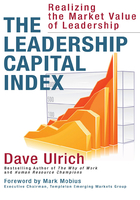
Logic of Leadership Capital Index
A leadership index differs from a leadership standard. Standards define what is expected; indices rate how well an activity performs. For example, consider the Economist’s Big Mac index, which measures the cost of a Big Mac in various countries in terms of its difference from the average Big Mac price in the United States. The index doesn’t try to tell you how much a Big Mac should cost—rather, it is a crude but useful assessment of the cost of living around the world.
An index guides investors to make more informed choices. When a rating agency like Moody’s or S&P downgrades a company, it is not saying the company did or did not meet financial reporting requirements. It is offering an opinion about the firm’s ability to repay loans in the future. Likewise, a leadership capital index would inform investors and others about the readiness of the firm’s leadership to meet business challenges.
I am not proposing some sort of leadership equivalent of generally accepted accounting principles (GAAP)—this is not an attempt to codify all leaders in the same way. Developing such a leadership standard would be nearly impossible because leadership is inevitably both personally subjective and contingent on the unique needs of the company. Defining a leadership standard would be like defining the perfect basketball player. Both Michael Jordan and Bill Russell were enormously successful, but they had very different skills, played in different eras, and had different roles on their teams. Likewise, it is silly to ask who was or is the best leader—Bill Gates, Richard Branson, Indra Nooyi, Ratan Tata, Carlos Ghosn, Warren Buffett, Zhang Ruixin, Steve Jobs, Larry Page, Oprah Winfrey, or Jack Welch? In fact, each was very successful using unique skills appropriate for the circumstance. In the near future, no uniform standard of leadership is at all likely, but an investor who recognized the quality of leadership in each of these leaders and thus invested in them early on would have been well served. A leadership capital index can give investors and other interested parties a set of guidelines to assess leadership.
When my colleagues and I share our aspiration to develop a leadership capital index, almost everyone agrees that this would be a marvelous resource. Some call it the holy grail for both firm valuation and leadership development, but most are skeptical that it can happen. However, the timing is now right, because both firm valuation and leadership improvement efforts have evolved to a stage where such an index can actually be created.
My current proposal for a leadership capital index follows the logic of the minimum viable product for innovation in high-tech. According to this logic, web applications and lean start-ups continually experiment to learn how to improve. The product is not wholly defined in advance; it develops as it is tested, used, and improved. In valuation and leadership, a number of initial efforts have been made to establish an investor view of leadership. By combining these separate but thoughtful initiatives, we can now create a more rigorous and holistic leadership capital index. Leadership capital index 1.0 is to build the case for the index and establish a framework and baseline for the index, which is the purpose of this book.
According to this logic, web applications and lean start-ups continually experiment to learn how to improve. The product is not wholly defined in advance; it develops as it is tested, used, and improved. In valuation and leadership, a number of initial efforts have been made to establish an investor view of leadership. By combining these separate but thoughtful initiatives, we can now create a more rigorous and holistic leadership capital index. Leadership capital index 1.0 is to build the case for the index and establish a framework and baseline for the index, which is the purpose of this book.